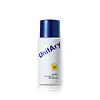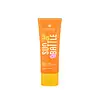What's inside
What's inside
 Key Ingredients
Key Ingredients

 Benefits
Benefits

 Concerns
Concerns

 Ingredients Side-by-side
Ingredients Side-by-side

Zinc Oxide
Cosmetic ColorantIsododecane
EmollientCyclopentasiloxane
EmollientWater
Skin ConditioningGlycerin
HumectantButylene Glycol
HumectantCyclohexasiloxane
EmollientNeopentyl Glycol Dicaprate
EmollientTitanium Dioxide
Cosmetic ColorantPolyglyceryl-3 Polydimethylsiloxyethyl Dimethicone
Skin ConditioningPolymethylsilsesquioxane
Sodium Chloride
MaskingTrimethylsiloxysilicate
EmollientTriethoxycaprylylsilane
Acrylates/Polytrimethylsiloxymethacrylate Copolymer
Skin ConditioningPEG-10 Dimethicone
Skin ConditioningDisteardimonium Hectorite
StabilisingDextrin Palmitate
EmulsifyingLauryl PEG-9 Polydimethylsiloxyethyl Dimethicone
Skin Conditioning1,2-Hexanediol
Skin ConditioningHydroxyacetophenone
AntioxidantPropanediol
SolventAluminum Hydroxide
EmollientStearic Acid
CleansingTocopheryl Acetate
AntioxidantPolyhydroxystearic Acid
EmulsifyingLecithin
EmollientZinc Oxide, Isododecane, Cyclopentasiloxane, Water, Glycerin, Butylene Glycol, Cyclohexasiloxane, Neopentyl Glycol Dicaprate, Titanium Dioxide, Polyglyceryl-3 Polydimethylsiloxyethyl Dimethicone, Polymethylsilsesquioxane, Sodium Chloride, Trimethylsiloxysilicate, Triethoxycaprylylsilane, Acrylates/Polytrimethylsiloxymethacrylate Copolymer, PEG-10 Dimethicone, Disteardimonium Hectorite, Dextrin Palmitate, Lauryl PEG-9 Polydimethylsiloxyethyl Dimethicone, 1,2-Hexanediol, Hydroxyacetophenone, Propanediol, Aluminum Hydroxide, Stearic Acid, Tocopheryl Acetate, Polyhydroxystearic Acid, Lecithin
Water
Skin ConditioningEthylhexyl Methoxycinnamate
UV AbsorberNiacinamide
SmoothingCetearyl Olivate
Butyl Methoxydibenzoylmethane
UV AbsorberPhenoxyethanol
PreservativeDipropylene Glycol
HumectantHydroxyethyl Acrylate/Sodium Acryloyldimethyl Taurate Copolymer
Emulsion StabilisingPPG-3 Benzyl Ether Myristate
EmollientButyrospermum Parkii Butter
Skin ConditioningButylene Glycol
HumectantSorbitan Olivate
EmulsifyingAluminum Starch Octenylsuccinate
AbsorbentOctocrylene
UV AbsorberAcrylates/C10-30 Alkyl Acrylate Crosspolymer
Emulsion StabilisingChlorphenesin
AntimicrobialPropylene Glycol
HumectantAminomethyl Propanol
BufferingParfum
MaskingAllantoin
Skin ConditioningTetrasodium EDTA
Glycyrrhiza Glabra Root Extract
BleachingGlycerin
HumectantLecithin
EmollientMentha Piperita Leaf Extract
Skin ConditioningPolysorbate 60
EmulsifyingDimethicone
EmollientDimethicone/Vinyl Dimethicone Crosspolymer
Skin ConditioningGlycereth-20
HumectantPentylene Glycol
Skin ConditioningAmodimethicone
Carbomer
Emulsion StabilisingDisodium EDTA
Sodium Hydroxide
BufferingBHT
AntioxidantPotassium Sorbate
PreservativeSodium Benzoate
MaskingArbutin
AntioxidantCitric Acid
BufferingSodium Sulfite
PreservativeAcetyl Tyrosine
Skin ConditioningSaxifraga Sarmentosa Extract
Skin ConditioningPaeonia Suffruticosa Root Extract
Skin ProtectingAminopropyl Ascorbyl Phosphate
AntioxidantScutellaria Baicalensis Root Extract
AstringentGlutathione
Water, Ethylhexyl Methoxycinnamate, Niacinamide, Cetearyl Olivate, Butyl Methoxydibenzoylmethane, Phenoxyethanol, Dipropylene Glycol, Hydroxyethyl Acrylate/Sodium Acryloyldimethyl Taurate Copolymer, PPG-3 Benzyl Ether Myristate, Butyrospermum Parkii Butter, Butylene Glycol, Sorbitan Olivate, Aluminum Starch Octenylsuccinate, Octocrylene, Acrylates/C10-30 Alkyl Acrylate Crosspolymer, Chlorphenesin, Propylene Glycol, Aminomethyl Propanol, Parfum, Allantoin, Tetrasodium EDTA, Glycyrrhiza Glabra Root Extract, Glycerin, Lecithin, Mentha Piperita Leaf Extract, Polysorbate 60, Dimethicone, Dimethicone/Vinyl Dimethicone Crosspolymer, Glycereth-20, Pentylene Glycol, Amodimethicone, Carbomer, Disodium EDTA, Sodium Hydroxide, BHT, Potassium Sorbate, Sodium Benzoate, Arbutin, Citric Acid, Sodium Sulfite, Acetyl Tyrosine, Saxifraga Sarmentosa Extract, Paeonia Suffruticosa Root Extract, Aminopropyl Ascorbyl Phosphate, Scutellaria Baicalensis Root Extract, Glutathione
Ingredients Explained
These ingredients are found in both products.
Ingredients higher up in an ingredient list are typically present in a larger amount.
Butylene Glycol (or BG) is used within cosmetic products for a few different reasons:
Overall, Butylene Glycol is a safe and well-rounded ingredient that works well with other ingredients.
Though this ingredient works well with most skin types, some people with sensitive skin may experience a reaction such as allergic rashes, closed comedones, or itchiness.
Learn more about Butylene GlycolGlycerin is already naturally found in your skin. It helps moisturize and protect your skin.
A study from 2016 found glycerin to be more effective as a humectant than AHAs and hyaluronic acid.
As a humectant, it helps the skin stay hydrated by pulling moisture to your skin. The low molecular weight of glycerin allows it to pull moisture into the deeper layers of your skin.
Hydrated skin improves your skin barrier; Your skin barrier helps protect against irritants and bacteria.
Glycerin has also been found to have antimicrobial and antiviral properties. Due to these properties, glycerin is often used in wound and burn treatments.
In cosmetics, glycerin is usually derived from plants such as soybean or palm. However, it can also be sourced from animals, such as tallow or animal fat.
This ingredient is organic, colorless, odorless, and non-toxic.
Glycerin is the name for this ingredient in American English. British English uses Glycerol/Glycerine.
Learn more about GlycerinLecithin is a term for a group of substances found in the cell membranes of plants, animals, and humans. They are made up of mixture of phospholipids.
This ingredient has emollient and emulsifying properties.
As an emollient, lecithen helps soften the skin and creates a barrier to keep moisture in.
As an emulsifier, it also helps prevent water and oil ingredients from separating. Lecithin can also help ingredients be better absorbed by the skin.
This is because the phospholipids in lecithin produce liposomes. Liposomes help other ingredients get through the skin barrier.
Depending on the source of this ingredient, lecithin may not be fungal acne safe. This is because some sources of lecithin come from soybean oil, which may feed the malassezia yeast that feeds fungal acne.
We recommend reaching out to the brand you are purchasing from to inquire about the source of their lecithin.
Some other names for this ingredient include soy lecithin and deoiled soy lecithin.
Learn more about LecithinWater. It's the most common cosmetic ingredient of all. You'll usually see it at the top of ingredient lists, meaning that it makes up the largest part of the product.
So why is it so popular? Water most often acts as a solvent - this means that it helps dissolve other ingredients into the formulation.
You'll also recognize water as that liquid we all need to stay alive. If you see this, drink a glass of water. Stay hydrated!
Learn more about Water